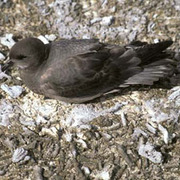Murphy's Petrel
Pterodroma
ultima
Procellariiformes
The tube-nosed seabirds, as this group is sometimes called, spend much of their life on the high seas out of sight of land, gleaning food from the water's surface. For most, the nesting season is the only time of the year that they touch land. They are drably colored—usually gray, black, or brown, with white—and range in size from small to very large. External nostrils on the upper mandible endow these birds with an unusually well developed sense of smell and contain a gland used for excreting salt. The order has four families worldwide, of which three are represented in Washington:
Procellariidae
This group is diverse and ranges widely in size. A common trait that all members of this family share is that their nostrils are located in a single tube at the top of their bills. Most maneuver well in high winds, and many migrate long distances. Most, but not all, nest in burrows. Those that do nest in burrows visit them only at night. The well-developed sense of smell of the shearwaters may help them find their burrows in the dark.
General Description
Several records between April and September, the earliest in 1992'mostly far offshore in the Pacific.
Family Members
 Northern FulmarFulmarus glacialis
Northern FulmarFulmarus glacialis Murphy's PetrelPterodroma ultima
Murphy's PetrelPterodroma ultima Mottled PetrelPterodroma inexpectata
Mottled PetrelPterodroma inexpectata Cook's PetrelPterodroma cookii
Cook's PetrelPterodroma cookii Pink-footed ShearwaterPuffinus creatopus
Pink-footed ShearwaterPuffinus creatopus Flesh-footed ShearwaterPuffinus carneipes
Flesh-footed ShearwaterPuffinus carneipes Greater ShearwaterPuffinus gravis
Greater ShearwaterPuffinus gravis Wedge-tailed ShearwaterPuffinus pacificus
Wedge-tailed ShearwaterPuffinus pacificus Buller's ShearwaterPuffinus bulleri
Buller's ShearwaterPuffinus bulleri Sooty ShearwaterPuffinus griseus
Sooty ShearwaterPuffinus griseus Short-tailed ShearwaterPuffinus tenuirostris
Short-tailed ShearwaterPuffinus tenuirostris Manx ShearwaterPuffinus puffinus
Manx ShearwaterPuffinus puffinus

